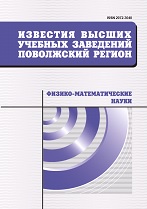|
Physics
The effect of temperature on dissipative electron tunneling through co nanoparticles in HfO$_2$ films
V. D. Krevchika, M. B. Semenova, D. O. Filatovb, D. A. Antonovb
a Penza State University, Penza
b Lobachevsky State University of Nizhni Novgorod, Nizhni Novgorod
Abstract:
Background. The purpose of this work is to experimentally and theoretically investigate the features of tunneling current-voltage characteristics (CVCs) for the case of one-dimensional dissipative tunneling in the limit of weak dissipation in an external electric field in the AFM probe-Co nanoparticle in an HfO2/Co film system. Another purpose is to experimentally confirm the theoretically predicted temperature dependence of the amplitude of a single peak of the mentioned tunnel CVC in a combined AFM/STM system for a single metal nanoparticle under the cantilever tip. Analysis of the current state of the quantum tunneling theory with dissipation and experimental work on the observation of the macroscopic dissipative tunneling effects for 1D and 2D systems with metallic and semiconductor nanoparticles (NPs) leads to the conclusion that the decisive experiment confirming the possibility of experimental observation of the dissipative tunneling effects can be the study of the temperature dependence of the tunneling I-V characteristics of these nanosystems. Materials and methods. The influence of temperature on the processes of dissipative electron tunneling through individual Co NPs in an HfO$_2$ film (10 nm thick) on a conductive substrate with a Co sublayer was experimentally studied by atomic force microscopy (AFM) with a conducting probe. Co NPs were formed by local anodic oxidation of the Co sublayer using an AFM probe with subsequent drift of Co ions to the AFM probe, their reduction, and growth of Co NPs near the contact of the AFM probe tip with the surface of the HfO$_2$ film. In the experiment, the tunneling CVCs of the formed Co NPs were measured when a voltage was applied between the AFM probe and the Co sublayer at different temperatures in the range of 20-105$^{\circ}$C. The experimental results were interpreted on the basis of the theory of one-dimensional (1D) dissipative tunneling. In this case, the one-instanton semiclassical approximation was used for the model 1D-double-well oscillatory potential at a finite temperature in an external electric field, taking into account the linear interaction with local phonon modes of the surrounding matrix. Results. It is shown that at one of the voltage polarities on the AFM probe, breaks in the CVCs were observed, accompanied by oscillations of the current through the AFM probe, which corresponds to the situation when the initially asymmetric double-well potential becomes symmetrical. It is found that the amplitude of current oscillations falls slightly nonlinearly with increasing temperature. The results of the experiment were compared with the results of calculations of the temperature dependence of the maximum amplitude of oscillations on the field dependence of the probability of 1D dissipative tunneling. The obtained qualitative agreement between the experimental and theoretical temperature dependences indicates that the experimentally observed features of the I-V characteristics are associated with the effect of macroscopic quantum tunneling with dissipation. Conclusions. The obtained results indicate the possibility of experimental observation of macroscopic dissipative tunneling effects in artificial nanosystems.
Keywords:
metal nanoparticles, dissipative tunneling, temperature-dependent features of tunneling current-voltage characteristics, atomic force microscopy.
Citation:
V. D. Krevchik, M. B. Semenov, D. O. Filatov, D. A. Antonov, “The effect of temperature on dissipative electron tunneling through co nanoparticles in HfO$_2$ films”, University proceedings. Volga region. Physical and mathematical sciences, 2023, no. 2, 108–121
Linking options:
https://www.mathnet.ru/eng/ivpnz537 https://www.mathnet.ru/eng/ivpnz/y2023/i2/p108
|

| Statistics & downloads: |
| Abstract page: | 42 | | Full-text PDF : | 11 | | References: | 10 |
|




 Contact us:
Contact us: Terms of Use
Terms of Use
 Registration to the website
Registration to the website Logotypes
Logotypes








 Citation in format
Citation in format 